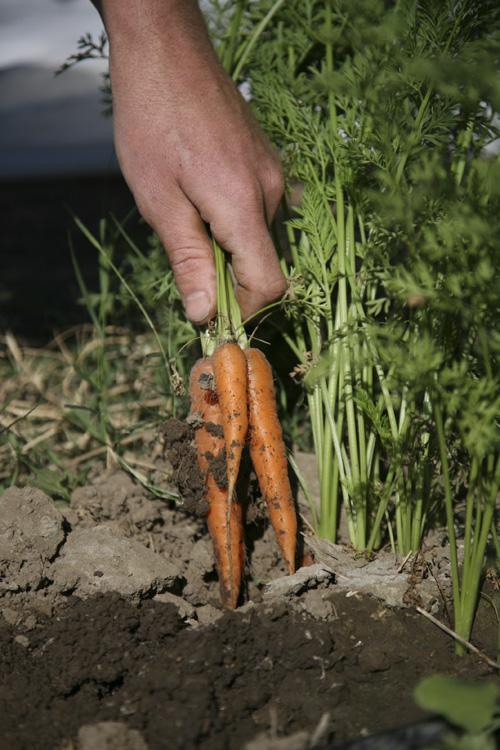Gardeners call it black gold for good reason: compost not only
feeds plants, but enriches the very ecosystem of the soil.
And these days, it doesn’t take an alchemist to create black
gold. While some residents have been composting for decades, the
recent interest in backyard gardening has led to a profusion of
easy-to-use, small scale composting systems available at local
gardening and hardware stores. Plans for do-it-yourself designs are
also plentiful, both online and in composting books.
“I think the important thing about composting is it works on
every level. If you have an acre, you can rake up your leaves and
compost them in a big pile outside. If you have a small house or
apartment, you can have a little bin on the patio or even under the
sink,” Windsor resident James Belisle, owner of Living Color
Nursery, said. “Taking your waste and making something useful out
of it is a great message.”
Before you get started, though, you must first decide between
vermiculture and traditional composting.
Vermiculture, or worm composting, has benefits and drawbacks.
Since it does involve live worms, a vermicomposting system requires
more maintenance and care than a traditional compost pile. Worms
are sensitive to temperature extremes, and must be monitored to
ensure an adequate but not overwhelming supply of food. Worms also
require bedding—typically damp shredded newspaper—to help regulate
moisture content and provide them with a comfortable habitat.
While this might sound complicated, for a family with small
children, vermiculture can be a great way to get children outside
and interested in recycling waste. Like traditional compost piles,
worm bins do not smell. But worm bins come with an additional
benefit that traditional compost piles do not: worm tea.
“Commercial bins are all designed with a way to capture the worm
tea,” Tom Danaher, floor manager at Harmony Farm Supply, said.
“Worm tea can be used as a liquid fertilizer or for foliar feeding.
It’s a way of really quickly addressing nutrient deficiencies.”
At Harmony Farm Supply, vermiculture kits start at $89.95. Worms
must be ordered separately. A good local source is Sonoma Valley
Worm Farm, which will mail you two pounds of red wrigglers for
$49.50.
The alternative to vermiculture is the traditional compost pile.
Worms are often present in this pile, but are not specifically
added. In this system, naturally occurring microbes decompose the
organic matter, and are assisted in their task by insects and
fungi.
A good compost pile requires a balance of brown, carbon rich
materials and green, nitrogen rich materials. Examples of brown
materials include dry leaves, straw, and dried out plant matter,
such as weeds that have been pulled and left to dry on a path.
Green materials include vegetable scraps, chicken or rabbit manure,
and freshly pulled weeds. (Note: green materials might not always
be green. Past-due produce and kitchen scraps such as red beet
skins, purple cabbage stalks, and yellow tomatoes all count as
green materials.)
The optimal balance between brown and green ingredients is
somewhere between half-and-half and three-to-one, depending upon
what sources are used. If you do not plan to turn your pile, be
sure to add extra lightweight brown matter. Composting is an
aerobic process, and leaves and straw will allow air to penetrate
inside the pile without turning.
But if you’re in a hurry, you’ll want to make sure not to add
too much brown matter. The green matter provides the fuel and heat
for the decomposition process, and helps speed things along. If you
want compost as soon as possible, you’ll also want to turn the
pile—because the more air you add, the faster your compost will
mature. To turn the pile, you can either use a pitchfork, or
purchase a special compost tumbling system.
Tumbling systems start at $99.99 at Garrett Ace Hardware in
Healdsburg; this system claims to mature compost in less than a
month, but only holds 6.5 cubic feet of organic matter.
With either sort of compost system—vermiculture or
traditional—there are certain things that can’t be added. Meat and
oily leftovers will spoil a compost pile. (To recycle those, get a
dog.) Bones shouldn’t be composted either. But feel free to add
eggshells to boost the calcium content of your compost, and tea
bags are also fair game.
It’s important to remember that if your compost smells funny, or
is full of flies, you’re doing something wrong.
“Healthy compost piles should smell good and be relatively free
of nuisances and pests,” Danaher said. For troubleshooting tips,
Danaher recommended “The Rodale Book of Composting,” “The Complete
Compost Gardening Guide,” and “Secrets to a Great Soil,” all
available at Harmony Farm Supply. “The troubleshooting guides in
these books help match symptoms to what’s going wrong in the pile,”
Danaher noted.
Vermiculture systems are already enclosed, but to prevent your
warm, food-rich compost pile from becoming a haven for rodents, use
wire baskets to keep them out. Use common sense and don’t leave
rotting vegetables on top of the pile, or you’ll soon find flies
hovering.
“If you add something pests like, then add a layer of straw on
top so they can’t access it as easily,” Danaher recommended.
There are also ingredients that can help things along. Local
garden stores offer compost inoculants to boost microbial activity.
Or you can take the “sourdough starter” approach, and use a bit of
old compost to help the new compost get started.
If you’re torn between vermiculture and traditional composting,
there’s no reason you can’t do both. “I think the best thing is to
have a compost bin and a worm bin side by side,” James Belisle
said.









